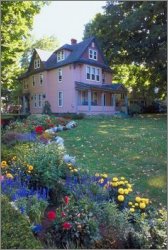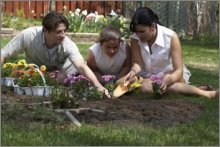|
|

|

15 Easy Landscaping Tips to Add
Appeal and Value to Your Home
by www.SixWise.com Perhaps because people are innately drawn to nature, or because
we're all driven on some level by aesthetics, creating a beautiful
landscape around your home is one of the most beneficial
things you can do to up its value.
|

Landscaping can increase your property value by 7 percent
to 14 percent, and make it sell five to six weeks faster!
|
Improved landscaping
can increase your property value by 7 percent to 14 percent,
according to the American Nursery & Landscape Association.
Meanwhile, if you're looking to sell your home, landscaping
can get your home sold five to six weeks faster than homes
without it (a definite plus in today's housing slump).
What's more, landscaping does not have to be a huge investment.
There are a number of simple tricks that can add major curb
appeal to your home -- without breaking the bank. The end
result is a relatively low investment for a high return --
not only in market value of your home but also in the joy
you'll get from beautifying your property.
15 Simple Landscaping Tips for Your Home
Now's the perfect time to get your yard in shape, so set
aside a few weekends, use the tips below, and you'll be on
your way to a beautifully landscaped yard that you can be
proud of.
-
Make a plan. Draw your yard on a piece of paper,
then plot out what should go where. This will help you
to get a mental picture of the finished yard, and ensure
that you have space for everything. Remember, complete
landscaping could take years to complete, so having a
plan will keep you on track.
-
Choose plants for all seasons. As you choose
plants, pick some that will flower in the spring, summer
and fall, along with varieties that will be attractive
in the winter, so you'll always have some visual interest,
no matter what the season.
-
Use perennials and annuals. Choose perennials
that you know you're going to love for the long haul (these
will come back each year). Annuals can be a bit more daring
and trendy, because they only last for one season. Further,
perennials only bloom for a certain period, so adding
in some annuals gives you more color for the summer.
-
Think about color. You'll want to add some splashes
of color throughout your landscape. Choose some brightly
colored perennials that will return year after year, and
also choose different colored bushes, flowering bushes
and trees (even plants and trees with just foliage come
in a wide range of colors).
|
Keep Pests Safely Away
From Your Garden
 Flea
'n Tick B Gone is an all-natural, completely non-toxic
insect repellant that will keep pests -- including fleas,
ticks, ants, spiders, bees, flies and more -- away from
your garden. Simply mist the area prior to working outside,
and you can garden in peace (and free of pests) for
at least three hours! Flea
'n Tick B Gone is an all-natural, completely non-toxic
insect repellant that will keep pests -- including fleas,
ticks, ants, spiders, bees, flies and more -- away from
your garden. Simply mist the area prior to working outside,
and you can garden in peace (and free of pests) for
at least three hours!
Flea 'n Tick B Gone is:
- 100% Pesticide Free and Non-Toxic
- Clinically proven to be highly effective
- A Great Value! It is economically priced
- Can also be used for your pets, on bedding and in
other pet areas of the home -- Simply lightly spray
in these areas
- Can safely be used as a preventive against fleas
and ticks: Regular use can naturally break life cycle
of fleas
- Controls/Stops other in-home pests like ants, bees,
flies and more
- Reduces risk of infections, dermatitis and itching
- Safely removes fleas, ticks, lice and other pests
from your yard
Find
Out More About Flea 'n Tick B Gone Now!
|
-
Add depth. When planting flowerbeds, choose taller
varieties for the back, shorter for the front and add
a medium level in between. You can also plant a circular
area this way, putting the tallest plants in the middle
and working your way out.
-
Trim your trees and bushes. Give your trees and
shrubs regular "hair cuts" to keep them neatly
shaped and well-manicured. (Think about the shape you
want ahead of time, such as round, cone-shaped, square
or more natural.) Along these lines, you should also keep
your lawn neatly mowed.
-
Add privacy and function. If you have neighbors
close by, you can use evergreens and trees to create privacy
and block views of other houses/unsightly areas. Evergreens
also make excellent wind barriers, if you live in a particularly
windy area. Meanwhile, if you want a shaded area or a
canopy overhead, planting a large tree will be ideal (but
should be avoided if you want to keep the area sunny and
open).
-
Cover unsightly areas. If there is an area in
your yard that you don't like (such as a gas meter or
utility box), use bushes, perennials or small trees to
hide it.
-
Edge the beds. Edging the spots where your grass
meets flowerbeds,
mulch or gardens adds visual appeal. Use a clean straight
line, or install a small decorative fence or stone lining
to define the space.
-
Watch your budget. Full-grown trees and plants
are expensive, but you can greatly cut down your costs
by buying smaller varieties (plants grow faster than you
think) or looking for sales. Trees and other big-ticket
items can even be purchased in the fall, when they're
likely to be discounted (and it's not too late to plant
them in the fall).
-
Create "rooms." If you're working with
a large, undefined space, adding "walls" to
create separate spaces can add a lot of appeal. Do this
by using hedges, trees, flowerbeds and arbors to act as
barriers (and don't forget to add a few pathways to connect
them).
|

Remember, your home's landscape is a work in progress.
It will be completed in phases and you can always make
new additions.
|
-
Use groundcover. Groundcover is an excellent
choice for covering large spaces or adding interest in
between trees and bushes. It comes in many different colors
and varieties, plus, it's low maintenance and will keep
weeds away.
-
Keep in style with your house/local region. Your
landscape should coordinate with your home (so if you
live in a Cape
Cod style home you shouldn't surround it with cactuses).
Meanwhile, not every plant will thrive in every region,
so choosing some native plants ensures that your landscape
will thrive and blend in with your local environment.
-
Keep maintenance in mind. If you know you don't
want to spend a lot of time maintaining your yard, choose
low-maintenance bushes, trees and perennials, and leave
the intricate flowerbeds, extensive annuals, rock gardens
and ponds to those who live to garden.
-
Plan your yard from all perspectives. The view
of your home from the street is important, but so is your
backyard and your view from inside the house. Keep all
visual perspectives in mind as you plan your landscape.
Recommended Reading
The
Secret Way to Add Value to Your Home: It's Easy, Relatively
Inexpensive & Beautiful!
Amazing
Facts about U.S. Homes & Home Owners, and the Most Common
Styles of Home in the USA
Sources
SmartMoney.com
To get more information about this and other highly important topics, sign up for your free subscription to our weekly SixWise.com "Be Safe, Live Long & Prosper" e-newsletter.
With every issue of the free SixWise.com newsletter, you’ll get access to the insights, products, services, and more that can truly improve your well-being, peace of mind, and therefore your life!
|
|
|
|